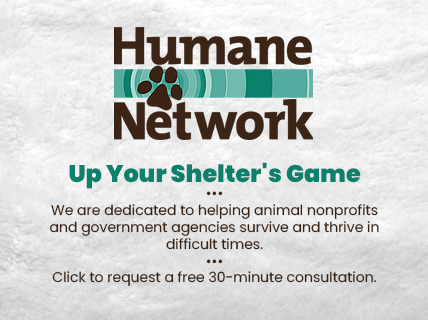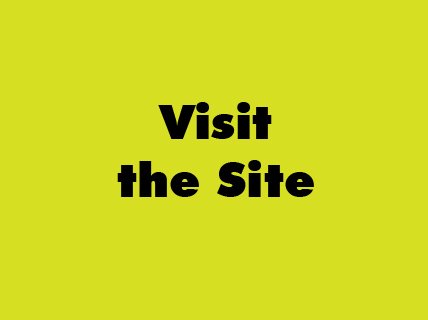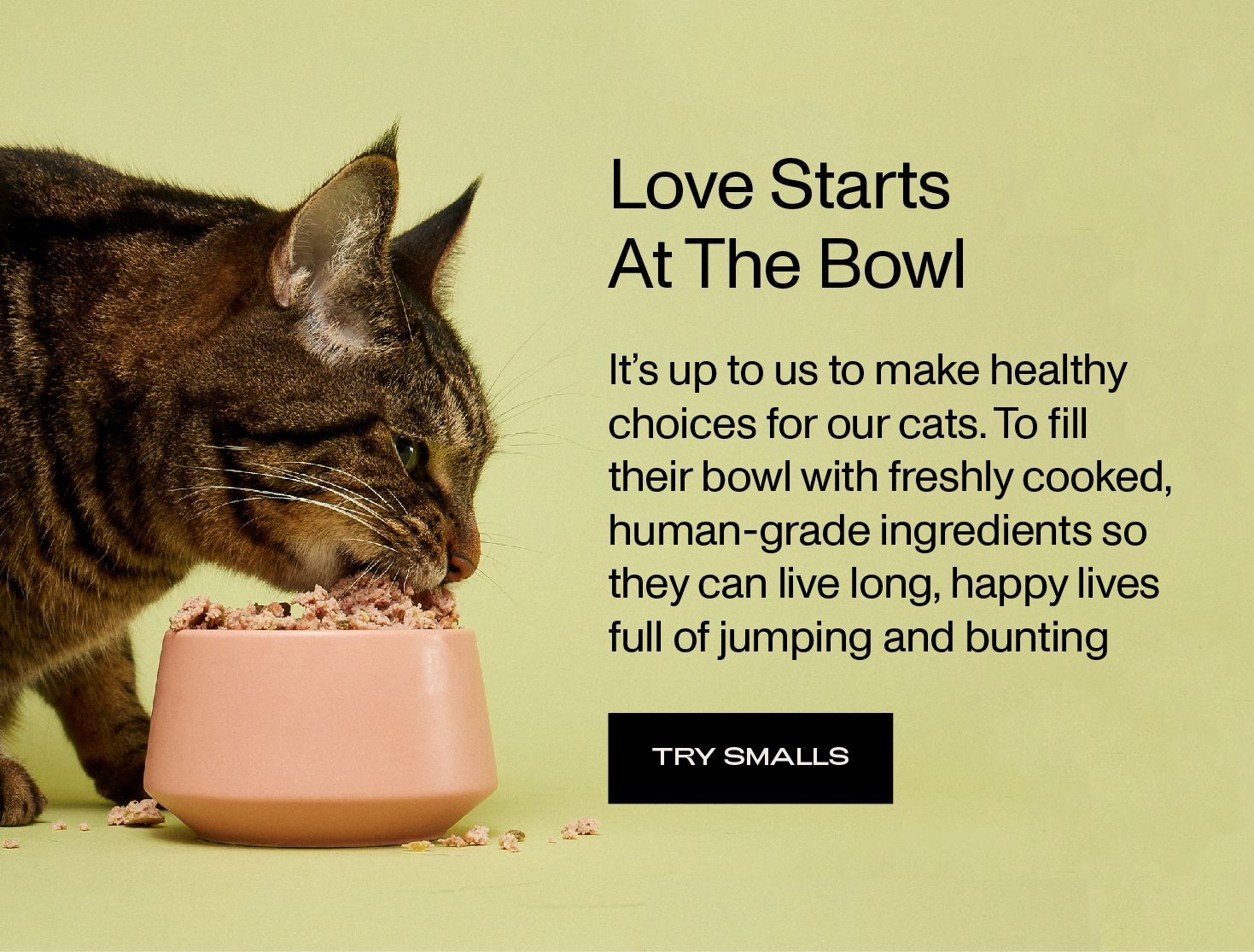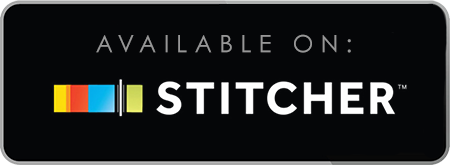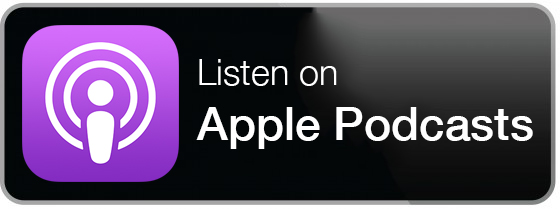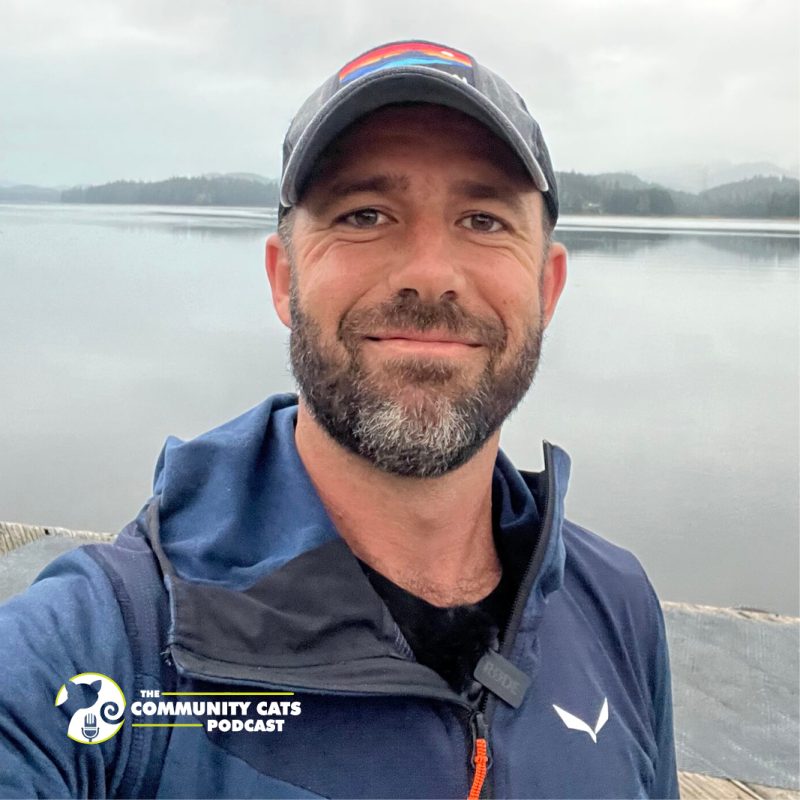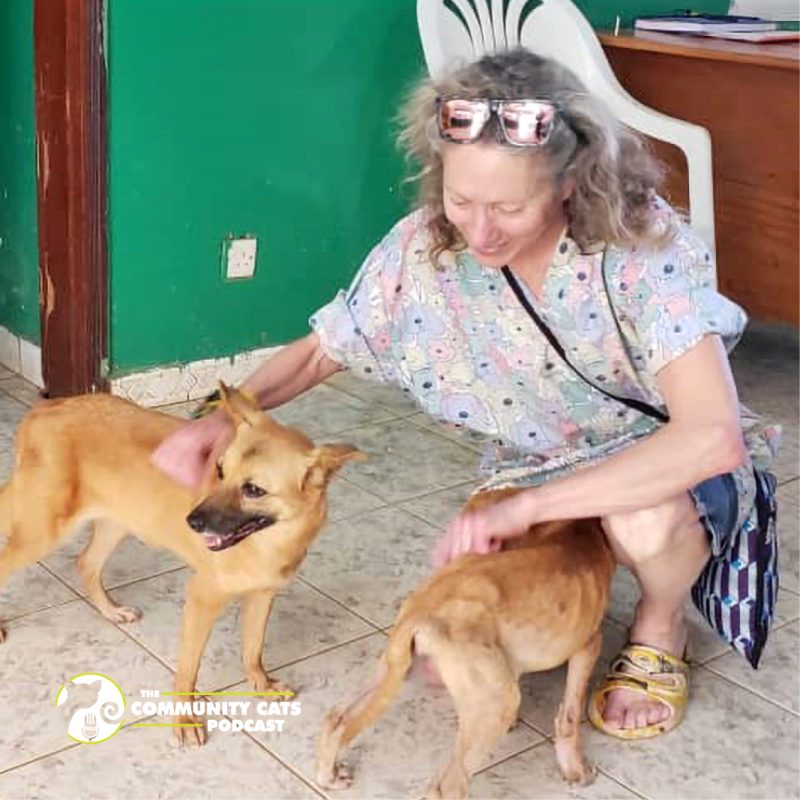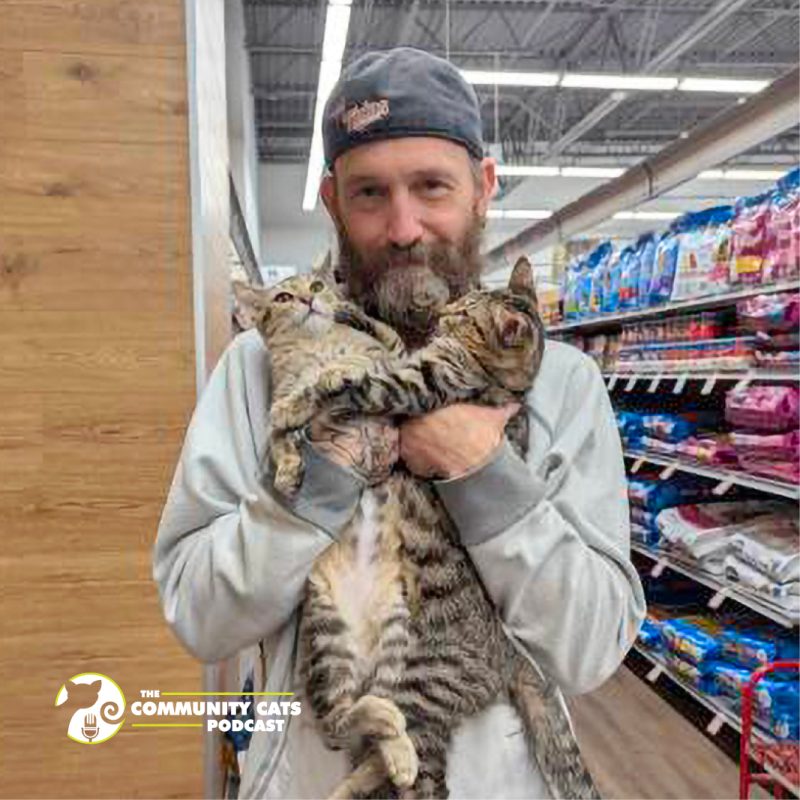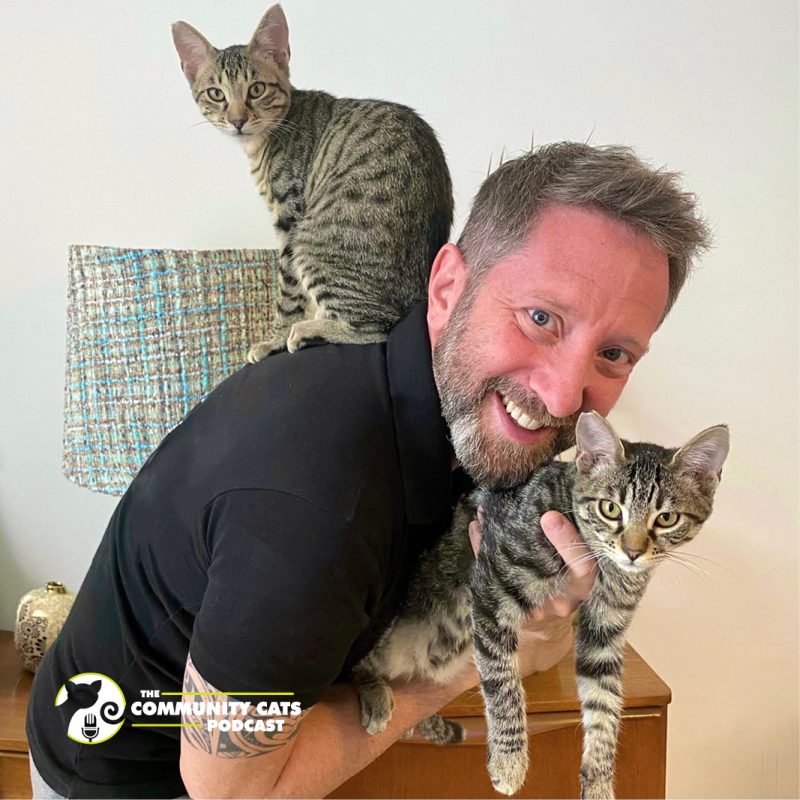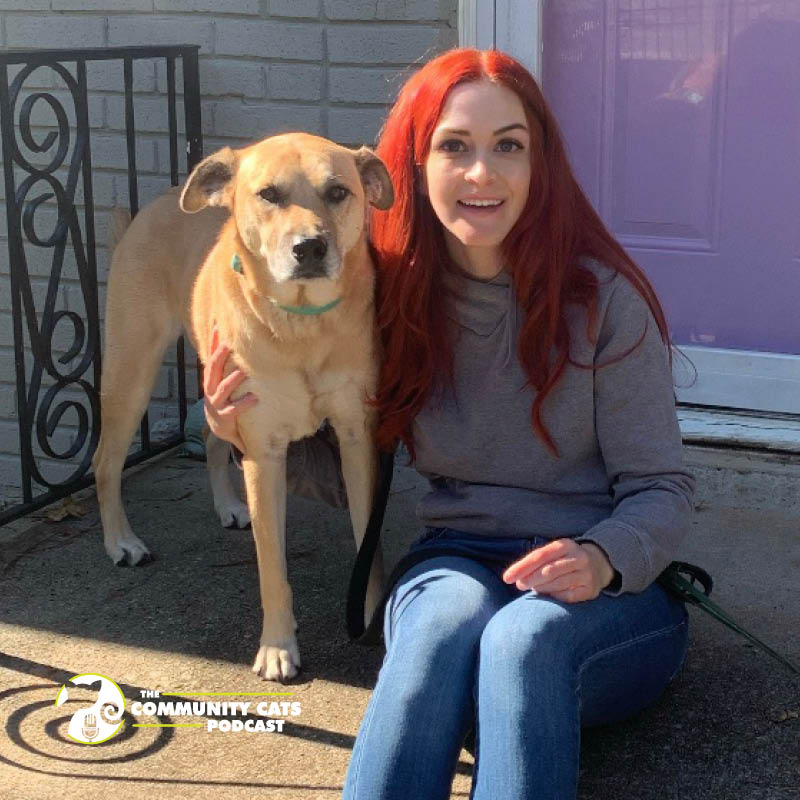
Beverly Means, LMSW, Founder and Executive Director of Transitions Pet Care
January 18, 2022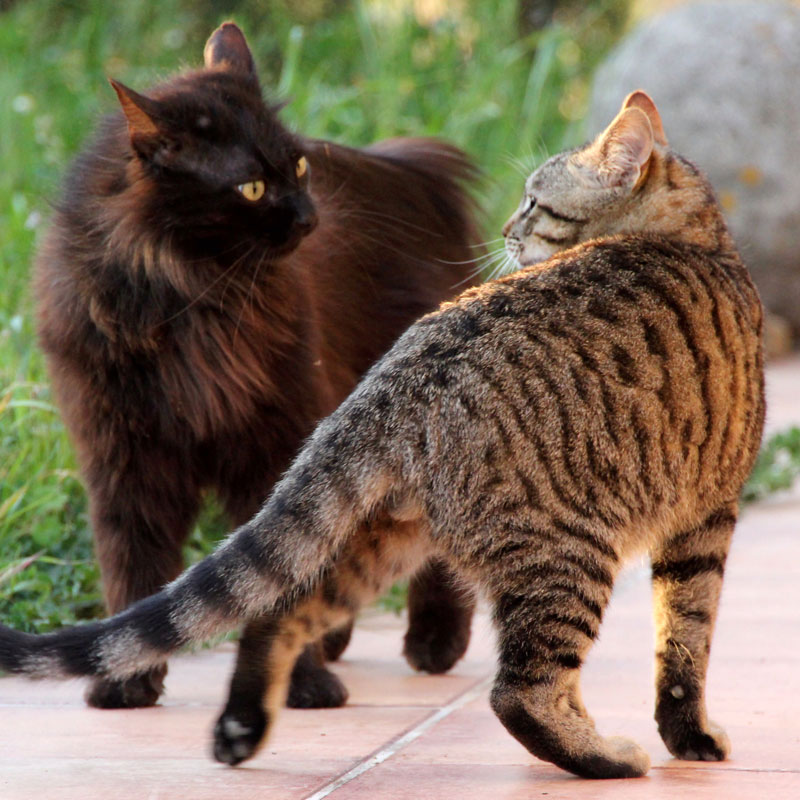
The Language We Use Matters More Than You Think
January 27, 2022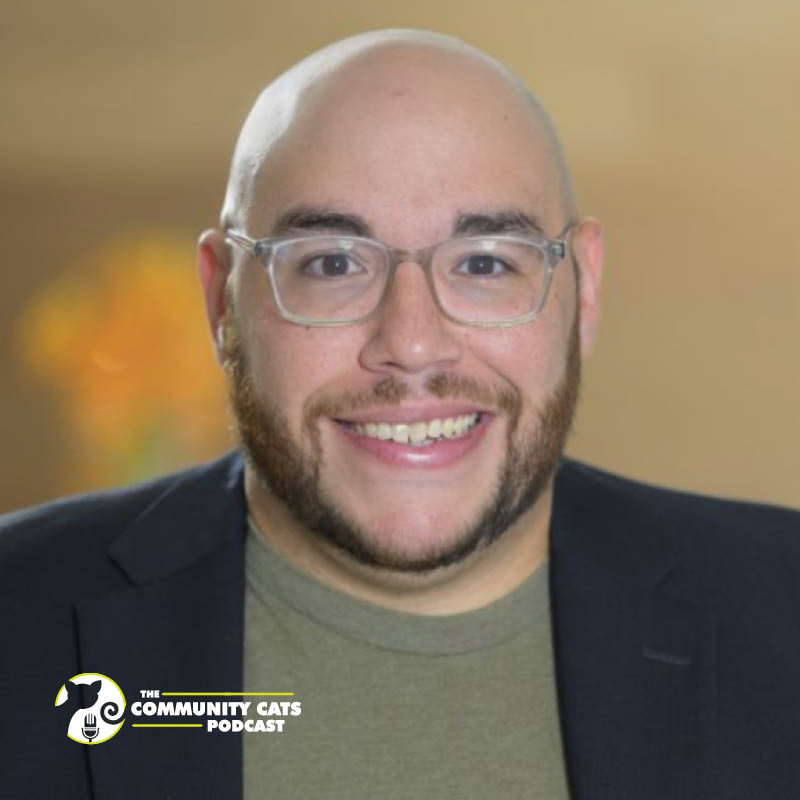
“For anything – as far as animals are related – to be completely sustainable, it has to happen in the community, it has to happen the community.”
Listen to Episode #440 Now
This episode is sponsored in part by Humane Network, Doobert.com and Maddie’s Fund.
Mike Bricker has spent years in animal welfare improving live outcome percentages, innovating new programming, rewriting policies, and modernizing medical operations as director of operations at Camden County Animal Shelter. He then transitioned to Best Friends Animal Society as the Director of Operations of the Shelter Embed program and used his time to connect with communities and listen to the people he worked with.
Stacy and Mike dive into what makes CARE, as Mike describes, “Unlike almost anything else in Animal Welfare.” He outlines the current divisions of CARE and talks about how CARE Centers, Research and Development, Narrative, and The CARE Circle work together to progress their mission.
Mike discusses the importance of narrative and visibility as a core of what CARE does to highlight Black and Indigenous People of Color (BIPOC) doing the unrecognized animal welfare work in their communities.
This visibility also has an impact on the future of BIPOC in the veterinary profession and animal welfare world. He relates, “Once they see themselves in the movement they find it way easier to jump into that movement.”
Mike and Stacy talk about the sustainability of animal transport, creating an organization that reflects the population they serve, and how communities/changemakers can find and work with CARE.
Notes:
During his interview, Mike mentions these organizations:
- Little Earth United Tribes
- Braveheart Animal Rescue
- Jodie Blackwell Fund to develop scholarships/support for Black Veterinarians.
- TrapKing Humane
To learn more about CARE, visit them online or follow them on Facebook,and Instagram. Stay up-to-date with their programs and projects by becoming a member of the CARE Circle. To join, text CIRCLE to 52886.
Read Episode #440 Now
CommunityCatsPodcast_Ep440_Bricker_220125.mp3
Kristen Petrie [00:00:03]
You've tuned in to the Community Cats Podcast. Ready? Let's go.
Stacy LeBaron [00:00:13]
Welcome to the Community Cats Podcast, I am your host, Stacy LeBaron. I've been involved helping homeless cats for over 20 years with the Merrimack River Feline Rescue Society. The goal of this podcast is to expose you to amazing people who are improving the lives of cats. I hope these interviews will help you learn how you can turn your passion for cats into action. Today, we're speaking with Mike Ricker. Mike is the Chief of CARE Centers. Mike will be developing organizational strategy, and sustaining that through the management of all our CARE Centers. Mike will develop a national model for workforce development that partners from the community up to local shelters to provide sustainable change and save more animals. Mike comes to CARE as the former Director of Operations for the Shelter Embed program at Best Friends Animal Society. He spent most of his time in Texas as interim executive director at different shelters where he used his compassionate talent to get to know the staff, put the time in to connect with the community, all while saving more animals. During his time in Texas, he was able to take PVAC from a 34% live release rate to 93% and Abilene from 55% to 89%. Before Best Friends, Mike was the Director of Operations at Camden County Animal Shelter (CCAS). In addition to rewriting the shelter's adoption policies, Mike helped to create a life-saving department launch, CCAS’s community cat program, pioneer the Rent-A-Dog program, and modernized the shelter's medical operations. Wow, what a lineup. Mike, welcome to the show.
Mike Bricker [00:01:48]
Hey, thank you so much.
Stacy [00:01:52]
It’s great having you here, and it sounds like you you've been all over the place. But before we jump into your journey, tell me first: how did you become passionate about cats?
Mike [00:02:01]
I can't remember like when it all started. But, I mean, I just from as long as I can remember, I've always loved cats. Always love cats and dogs but I had a special relationship with a community cat when I was little. I just thought it was so cool that, you know, he would keep coming back to our house to be fed and I guess that's the start of my love and passion for cats.
Stacy [00:02:22]
You know, it's really interesting because there was a cat that I sort of named Watson. I don't know why. I thought he looked like a Watson and he was in Cambridge when I was living in Cambridge. An old toothless fellow who lived under the porch of a house around the corner from where my apartment was, and this was back in the late 80s, early 90s and, you know, I didn’t know what a community cat was. I just knew it was Watson, you know. I needed some tuna and food and some help and so I know we've sort of professionalized all of this business with cats being outside, you know. So the work that you're doing, I mean, how is it impacting just folks that are out there that just want to feed those Watsons?
Mike [00:02:55]
Yeah. I mean in a big way. I mean, I think CARE, what CARE’s doing for people on the street level, or in the community, is unlike almost anything else in animal welfare. One of our biggest CARE partners is Sterling Davis, the TrapKing, you know. So we are, we're definitely supporting Sterling in all of his, you know, getting him out to other areas. He's actually visited us in Philadelphia, Camden, in the month of November; it was a huge hit. I'll bring him other places, but also, you know, it's just when we're starting CARE Centers and CARE partnerships, we're looking for people that are inside the community that are doing work just like that, other people like Sterling but in their community that are trapping cats. We work really hard to support them and anything they need.
Stacy [00:03:45]
That's great. So, tell me more specifically about CARE. You know, you shared a little bit. When did CARE get started? You know, how is it working? I mean, you say you're looking with people who are trying to support their businesses, getting out in the community that kind of thing, but just tell me about your origins and you're into all this strategy, so, you know, what’s CARE going to be doing too.
Mike [00:04:08]
Yeah, well CARE’s doing a ton and CARE started a little over a year ago now and we have different divisions. So each division kind of focuses on something different. So we have the Narrative division, which I think is, all divisions are super important but I really love this portion a lot, Narratives. And the reason is, you know, there's tons of people doing this work. There's tons of BIPOC people that are doing this work but you don't see them highlighted in animal welfare at all and what our narratives division is doing is find those people and putting a spotlight on them doing the work in their community so that it's not just a Sterling Davis, you know, as the only African-American cat trapper and we know that's not true, right? But he's the only one we see, there's a bunch of others out there. So we're working to find those people and highlight and spot put a spotlight on them. I think by doing that, you know, it's going to bring other people into the movement. Once people see themselves in the movement, they find it way easier to jump in that movement. It's harder when you don't think that there's people like you doing these things. So I think the narratives division is huge and I think that's going to make such an impact on animal welfare as a whole, just having somebody out there looking for those people and putting a spotlight on those people. Then we have Engagement, which is amazing as well. We just started the CARE Circle, which is like a membership. If you want to know everything that, you know, we're doing at CARE, you join the Circle, but also we're using it as a tool for CARE Centers and giving our CARE Center partners a tool that they can grow and have and start to collect people in the community that want to help them do things. The CARE Circle gives that CARE Center partner an ability to reach out to all of the people that joined their circle and if they have an event that they need volunteers for or if they just found a kitten that they need a foster for, they're able to then send a text message or a mass email out to all those people and I think what's so cool about the Circle is the way that you get added to it. You know, everybody's on their cell phone, so instead of going on a website and filling out a large form, you can join the Circle that way or you can join the Circle just by texting 52886, texting circle to 52886, and it's your joined like that. So then your added to their circle and then that person can contact you and keep you informed on everything their organization’s doing. Then you have Research and Development, which is huge. You know, so we're doing research inside the communities, you know, we worked with a community in Minneapolis, they're called a Little Earth of United Tribes. It’s small community. It's one of the only communities inside of a city, an urban community tribe I should say. An urban tribe that's it's not just one tribe like a Cherokee or Red Lake. It's actually 30 different tribes that call this area of Minneapolis their home and we are doing some research there. We're trying to figure out how many animals are in that that community and how we can get them services and support, but Research and Development’s doing a lot of big things. And then we have CARE Centers. So CARE Centers is, that's what I oversee. That's my passion and really all these things kind of help out CARE Centers as well. Like Research helps us, make informed decisions, you know, Narratives going to help us spotlight on that, and Engagement’s going to get us the people we need to really support those that are our CARE Center partners.
Stacy [00:07:41]
So tell me about CARE Centers because I’m sure that's going to be my interest and my passion and I'll share with you my experience. I've had a conversation with James about this before to which when I was exploring going into new communities to help with their community cat issues and it was sort of in the early days where we were thinking about targeting and the importance of targeting. So I think we're sort of shifting, some of our thought process a little bit we still are targeting but maybe we're calling it a different thing more like, you know, immersion or that kind of thing. So when I went into what I would call a new community, I would go in but I would create a committee, or I'd head up a committee helping with bringing resources into that community but creating a self-sustaining model, so that then, after about two years, ideally, after about two years, I would feel comfortable. And I'm sure you're comfortable with this conversation from Best Friends, because a lot of Best Friends work goes this way is where you go in and you create your, your program, your model, your support, your folks, you get your tribe together and then you leave because then they are self-sustaining. How is this CARE Centers different from that kind of model?
Mike [00:08:43]
So yeah, I definitely know a lot about that, that model that you're talking about. Working at the Embed program that's what I did; I went into these communities, you know, started building that program up and then and then left usually after a year or two and it works it definitely works, but I think with this, with what CARE Centers are doing is instead of Mike Bricker going to this community, we're finding the Mike Bricker that's already in that community and building off them. So we're supporting that person so that way there's nobody, that's leaving. You know, there's no change of hands at all. It's this, this person that's already in the community, that's doing this work that just needs some support with X, Y, and Z, we're providing that support and helping build that team that CARE Center around them. And really, you're not going to see like, a lot of, like CARE stuff when we go in there, it's not going to be like CARE plastered all over Camden, Philadelphia, or CARE plastered all over Atlanta. It's really the organization that we help to build, that's who we're going to highlight there. So like in Atlanta we have Braveheart Pets and when we do messaging in Atlanta, It's all about Braveheart Pets and then CARE takes the backseat, you know, because it's really about that organization, how they're going to make the changes for their community because they're from the community, they have the solution, you know, we're just going to support them in that way.
Stacy [00:10:01]
So I'm going to ask you another loaded question here. So we have so many people out there that are doing such great work, trapping on their own. We hear all these stories through the trapper certification workshops we do here with Community Cats Podcast in partnership with Neighborhood Cats on a monthly basis and I was saying earlier, before we hit the record button, like it's about 70 to 80% of the people are not at all involved with an organization. However, I get a lot of emails from folks saying, you know, I'm thinking, I need to create a non-profit because I'm now doing this so much. And so many people are asking for my help, my assistance. So, are you looking for people with certain types of skills? Is there a process to go through, say hey, I would love to have some support and care because I want to do this, I think I can do this, but I don't know how to do this. How do you recruit folks to be those leaders?
Mike [00:11:01]
Yeah, definitely. So, I mean, it's just like that. Honestly, we don't have to do much for recruiting people, people come to us and that's good and, you know, it's difficult at times because obviously we can only do as much as funding allows and as time allows. We’re much bigger than we were a year ago, but we were still only at seven person team right now. So, right now we're focusing on certain areas of the country. So if yeah, if you are in those areas that you see are CARE Centers in which right now, it's Miami, Atlanta, Philadelphia Camden and then parts of Minnesota. If you see our CARE Centers in your area and you want to be a part of it, definitely reach out. I would say that, you know, we're going to be sending out more information, like I said as funding allows on how we can, you know, grow that and go into markets that we haven't reached yet, but they can find that out just by joining our CARE Circle; that's how they're going to get all that information
Stacy [00:11:51]
And do these people have to be a 501(c)(3)?
Mike [00:11:55]
No, not at all. Actually we've helped, you know, multiple organizations, you know, start their 501(c)(3) and get that. You know, Braveheart Pets, Tim Freeman in Atlanta, he just had the idea and we've been working with him over the past six or seven months to kind of build that out. He's now a registered 501(c)(3) non-profit. He’s trained dogs, but no, they don't have to have that will help them.
Stacy [00:12:15]
Being out there on the field, seeing people who are out there on the field with Sterling and others involved with community cats, what do you see as being the greatest challenges for us going forward?
Mike [00:12:26]
I think our biggest challenge is getting more people on the team, you know, getting more people to the table or like, we like to say at CARE, like, throwing out that old table and building a new table. I think for far too long, there's only been if we're using like a football reference. It's all quarterbacks in the team, you know, we need to diversify. We need to have more people on the team and the communities that we need to reach the most, it's those people that we don't see on our team yet. So I think the more we can do to hire different board members, to make sure that your staff looks like the community that you're serving, to make sure your volunteers look like the community that you're serving, to really change your messaging to focus on those communities that really need our help, I think that's going to be the best way to do these things. Like, I think that's why it's so cool having Sterling have a platform that he does, you know, because I think just by him existing and for that spotlight being on them and it's quite the spotlight now, I mean the Netflix show that he did. He was on Shark Tank. He's doing like, you know, the Tabby dates, all sorts of stuff. I mean, we get so many messages just saying that like, you know, I always want to work with cats, always wanted to work and animal welfare, but seeing Sterling makes me know that I can do it. And I think, the more people that we highlight the easier, this is going to be for all of us, you know, it's always easier when you have a bigger team.
Stacy [00:13:59]
Yeah. I'm really thrilled to have this conversation because we'll be continuing it to a certain degree at the online cat conference in a few days. I think that that's going to be really exciting. So, for folks that are interested in joining us at the online conference, you can go to communitycatspodcast.com. Check out, sign up for the online cat conference. It's a whole weekend all about cats and Mike will be joining us and I'm just really thrilled to be able to continue this conversation. You know, in your bio, you talked about creating a community cat program and I think there are a lot of people out there that, you know, would like to start something more organized. And you've, it seems like you've worn the hat, sort of, like, bigger organization individual person. I hear, “The big organizations, they should be doing this,” and then I hear from the big organizations, “Well, everybody should feel like they're responsible for this on their own and they can't expect everything from us on the big organization side of things.” Where is our middle road?
Mike [00:14:56]
I think the bigger organizations are doing a much better job about what you were talking about earlier on targeting and they're trying to figure out how to tap into these smaller communities, but the communities up until recently didn't know how to tap into those bigger organizations. So I think, I think those two sides are starting to come together and that's why I think that CARE Centers plays such a vital role in that and CARE, in general, plays such a vital role in that being that kind of middle ground, that's going to merge those two groups, the community level, and then the big organization, because we do myself, Kenny, Jen, James. Johnny, we've all worked for, you know, these bigger organizations as well. So we know the gaps there and all of us come from the communities that these bigger organizations are trying to reach, so we speak that language as well. So, think there is a middle ground and I think that everybody starting to realize it, especially the big organizations. They're starting to realize how they can really, you know, access those communities. But yeah, that's the whole that's the whole reason CARE was created is to really be that advocate for the communities, support them until, you know, a day when we don't need the bigger guys, you know. Once these communities are self-sustainable, those bigger guys can pivot on something else, you know. I think for anything as far as animals are related to be completely sustainable, it has to happen in the community and it has to happen by the community. I think where the bigger guys get in trouble is that they do give, give, give but then they have the same struggles with everybody. They can't give to everyone you know, or they have to stop giving to a certain point and that's when we kind of see this these programs fail, you know. But if the community has the program, they're running the program, it's for them, it’s by them, that's going to be sustainable. They're going to keep that going,
--Start mid-roll advertising-- [00:16:56]
We interrupt this podcast for a quick trivia question. Where's the single place with answers to all of your animal welfare questions? Yes, even the one that kept you awake until 2:00 in the morning. Anyone? Anyone? Bueller? It's Maddie's Pet Forum. Maddie's Pet Forum is the only dedicated forum for our industry where you can find answers from colleagues fast and free. Stop doom scrolling and join today. Visit forum.maddiesfund.org/cats.
[00:17:21]
Could your animal welfare organization use a tune-up? Humane Network can help. You can get a free 30-minute consultation to talk through your challenges and get ideas on how your organization can be more successful with less stress from board development and fundraising to strategic planning and operations. Humane Network has got you covered whether you were a large or small nonprofit or government. It's a live and thriving program led by a certified animal behavior consultant. Features specially designed training for shelter and clinic staff on enrichment, stress reduction, safe, animal handling, and behavior modification. With Humane Network, you receive individualized advice and support customized to meet your organization's unique needs, and Humane Network can lighten your load by taking on fundraising communications and other tasks you struggle with. Contact Humane Network today for a free 30-minute consultation. Visit humanenetwork.org. That's humanenetwork.org.
[00:18:13]
A simple picture of an animal and foster or needing adoption just doesn't cut it; adopters want to see video of the animal in action showing off their personality but shelter software doesn't let you get video back from fosters or staff easily. They can't text it because video is just too big and posting to YouTube means you have to give them access. If only there was a way for you to get video back from anyone that you can use in your organization. Luckily the team at Doobert has solved this problem with their RescueTUBE module. Now you simply create a bucket and give that code to any of your staff, volunteers, or fosters to type into the Doobert mobile app. They can easily upload videos up to 10 minutes that you can easily download and use in your adoption efforts. Organizations across the country are using Doobert’s RescueTUBE to capture video of foster animals, adoption, events, playtime, and behavior testing. ACOs are even using it to document cases in the field so they have video evidence. Check out RescueTUBE today at www.doobert.com where they make animal rescue simple.
--End mid-roll advertising-- [00:19:22]
Stacy [00:19:23]
So, you mentioned earlier about diversity on boards, and, you know, being representative of your community in the community you serve, which means you have to have an understanding of who you serve and sometimes some organizations, at least the smaller ones. I know, they're just reacting all the time. You know, I don't care what this call is coming, I'm getting that litter of kittens. I'm getting that mom spayed and I'm just dealing with it and I'm done and blah, blah, you know. So how do you get a diverse board? I mean, what are the barriers that you're seeing and then how do boards, it's not that they don't want to, but or is there a how or what is it that's embedded in us that's preventing us from becoming more diverse at the board level?
Mike [00:20:00]
Yeah, I think, I think it's that communication and that understanding of the community, right? So, like, how do people know what your organization does, you know? How do people find out about your organization? Generally, in animal welfare, we're in a vacuum. We're talking to ourselves, you know, so we're only going to find people that are in animal welfare or that are volunteers already. So we have to go out of that. We have to go into our community, you know, and I think that's going to help in more ways than just finding board members. Being active in your community, and I don't mean just by going there once a month, for a pet pantry, but truly being out in your community, like, for big shelter organizations, having your animal control officers, go out and, you know, without their ticket book, and just knock on doors and say hi, talk to people, or go to community events or, you know, show up at the dog park and just throw, you know, a ball around and just talk to people, start joining community events or being a part of community events that have nothing to do with animals at all, you know, a craft show or something like that. But really being involved in your community, that's how people that are outside of this sphere are going to find out about you and then you're going to find all this community wisdom that's just sitting there. They have the answers. They know what needs to happen for their community. Accept them in at every level: staff, director board, whatever. Bring them in and you will see your organization change for the better.
Stacy [00:21:26]
Yeah, that's excellent. I'm going to pivot again here. I've got so many different topics rattling around in my mind. Okay, so yeah, I'm going to pivot again because I also want to talk about an issue with regards to transport. So, obviously it's been a heavier conversation in the dog world, but there is transport happening for cats, for sure, you know, and I think it's on the rise and it's growing. And I think at the end of the day, I always say, let's learn lessons from the dog transport. What can we learn so that then we're not going to be doing this with the cats, but I do hear of folks saying, well, you're taking all the good animals out of areas, transporting them out. And then you, you kind of leaving what I call the strange, odd, old, and dysfunctional, which is what the group I ran, Merrimack River Feline Rescue Society sort of specializes in adopting out, but as and I think there's a lot of us out there that are specialists on those kinds of cats because probably 90% of them all are that way anyway, but I digress going back to that statement. I do have a strong belief that, you know, our animals are our community. So that then if we're shipping some of them out, there is a vacuum effect, you know, of some kind and there's a shift in the mentality around are our cats. Do you have any thoughts sort of on that topic?
Mike [00:22:33]
On cat transport as a whole? Yeah, I mean, I think, I think the whole idea of transport in itself isn't a sustainable idea. I think it's so expensive, and I do think that it is just another Band-Aid, right? I think it's great for when, you know, like when I first went to Palm Valley, you know, we were taking in 30,000 animals, you know, 15,000 of those were cats. We were getting animals every single day. So we were trying to get them all out as safe and as happy and as healthy as we could as quick as possible, so we did a lot of transports actually to Canada with cats from all the way from Texas. They found their way in Canada, which was amazing, but it is, it's super expensive and you're still going to keep getting in those cats, right? You're not doing anything to kind of quell that. So I think for cats specifically, the answer I feel is TNR, you know, you do as much TNR, really focus on that. If you're going to spend the money, spend the money on creating a TNR program for your shelter or rescue or, or supporting people that are already doing TNR, support them heavily. I think that is, you know, something that we should think about. And then I often got that especially in my early days the shelter. When we're doing transports out that you're transporting all the kittens and all the cute ones, all the fluffy ones. They're going somewhere else and we're left with these, you know, tabbies or something, I don't know. But I think what makes those so special, the kittens and the fluffy ones, you know, I mean, it doesn't mean their personality’s any different. So I think if we start to really focus on what we have, when I ran the shelter in Camden 85% of the dogs were short, stubby blocky-headed pit bulls. We had a ton of them, you know, and that was when I first got to that shelter, they said that was their barrier of being like a no-kill shelter. They got all the same dogs and nobody wants these dogs and all this stuff, but we should really start to focus on those dogs, you know, I noticed that our marketing that went out, you know, we're sending out a flyer about an adoption event and has like a Golden Retriever and a fluffy Persian cat. Neither of those animals were in a shelter and they probably won't be, you know, so start really focusing on that on the animals that you have and telling their stories and talking about them a little bit in a much, a much better light, not really focusing on those ones that like, the fluffy ones, the golden retrievers. Like all those, there's really cute like Persian cats, they're not going to ever lose their life in a shelter. They're going to be saved, right? So no matter what they come, we’ll figure those guys out there going to find their way out. We have to focus on the animals that need our help the most and kind of telling their stories and making them just as popular as a fluffy ones and the Persians and stuff like that. So I think that's what we did at my shelter in Camden and it worked, it worked big time, you know, but I think yeah TNR and changing the way we market those cats would be my number one and my number two.
Stacy [00:25:40]
You talk about supporting folks, you know, of course, we've also talked a bit or you know, it's true in the industry. We've talked a little bit about, you know, spay/neuter. Not only just being neutered, but veterinary. So veterinarian shortage, vet tech shortage, and they're certainly, I mean, I don't think that there are a lot of African-American veterinarians out there, as well as all kinds of ethnicities with regards to veterinarians or technicians. Is there any extra support there for folks that are interested in pursuing those careers, which are really expensive to get educated?
Mike [00:26:07]
Yeah, so we have the Jody Blackwell fund right now where we're raising money. We were as close to a hundred thousand dollars and we're using that money to support black veterinarians. So, we are sending that money to schools. We have. I think six schools that have signed on, that'll be participating in this, and we're going to send them money for scholarships for black veterinarians, but I think that in itself is going to help, but I hate to go back to the same thing, I think it's the narratives too and highlighting those that are already out there. You know, there's an amazing show on Nat Geo called the Critter Fixers. If you haven't seen that show, definitely go watch that show. But the more we do to kind of highlight other people that are doing these jobs, I think it's going to help in the long run, you know. Unfortunately, I don't know of any quick fix for this issue of us having a shortage right now. But again, I think animal welfare has always been very active, like you, like you said earlier. So I think it's time that we start thinking proactively and, and really thinking about how can we build capacity for these people in the future. And I think one of those ways is highlighting those people to bring more people into this this career path.
Stacy [00:27:21]
So if I'm just an individual person and I'm interested in finding out more information or getting involved, you know, how would they do that?
Mike [00:27:30]
Our website first off, careawo.org. It's a great website. Has a bunch of different information. You can find information about all of our divisions. And then, joining the CARE Circle, I think is the easiest for everyone. So again, you're going to text Circle, to 52886. You're automatically joined at that point and then you'll start hearing about all the amazing stuff that we have coming up. We have like a ready certification. It's like a certification for shelter workers volunteers, really anybody? So you will be CARE certified. It dives deep into all the DEI strategies and really focusing on how we diversify and how that affects, you know, everything we do in animal welfare, really everything we do in our life. So yeah, I mean, I think that would be the best way, join that Circle and you'll hear about stuff in real time.
Stacy [00:28:24]
That's fantastic. And are you guys on social?
Mike [00:28:27]
Oh, yeah. Definitely. We have a Facebook, Instagram. We just started to TikTok not too long ago and we have a bunch of pages. We have Pages for our main-care page. We have CARE Centers. Now, we have the caregiver Circle page.
Stacy [00:28:40]
Oh, fantastic, great. Mike. Is there anything else you'd like to share with our listeners today?
Mike [00:28:45]
No, I think I think we covered it all. I mean, when we talked about this earlier, I was going to mention the Circle, but I mentioned that a couple times. So no, I think this has been a great conversation. Thank you so much for having us.
Stacy [00:28:57]
That's great. And I want to just share with all the folks out there, if you've got your passion for action, and you want to love your, love the cats, please reach out to CARE. Looks like and it sounds like they'll be able to help you. So, you know, just turn your passion for cats into action. I want to thank everybody for tuning into the show today, listening. Don't forget join our conference online cat conference at the Community Cats Podcast, it's going to be next weekend, the 28th through the 30th. It's going to be full of some great presentations. We have some awesome, awesome people. So thank you again. Mike, I want to thank you so much for being a guest on the show, and I hope we'll have you on again in the future,
Mike [00:29:38]
100%. Thank you so much.
Stacy [00:29:40]
That's it for this week. Please head over to Apple Podcasts and leave a review. We love to hear what you think and a five-star review really helps others find the show. You can also join the conversation with listeners, cat caretakers, and me on Facebook and Instagram and don't forget to hit follow or subscribe on Spotify, Apple Podcast, Google Podcast, YouTube, Stitcher, or wherever you listen to podcasts, so you don't miss a single show. Thanks for listening and thank you for everything that you do to help create a safe and healthy world for cats.

